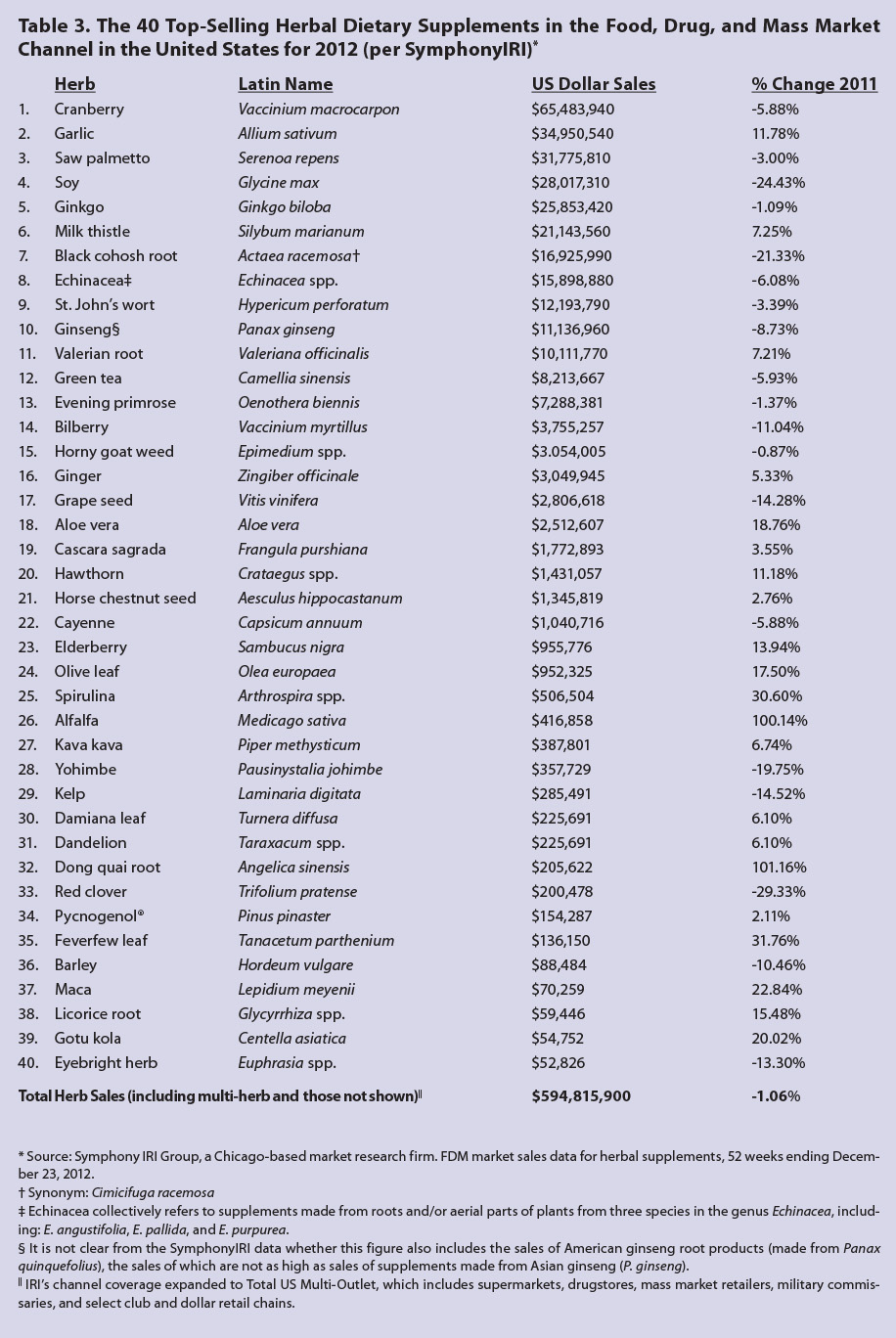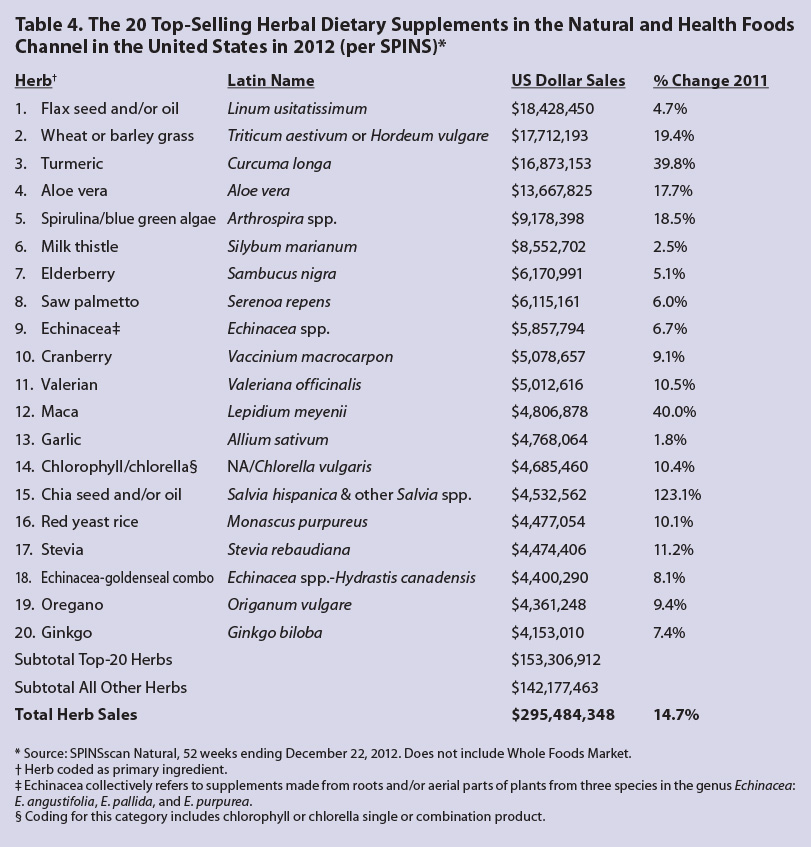Issue:
99
Page: 60-65
Herb Supplement Sales Increase 5.5% in 2012: Herbal Supplement Sales Rise for 9th Consecutive Year; Turmeric Sales Jump 40% in Natural Channel
by Ashley Lindstrom, Carla Ooyen, Mary Ellen Lynch, Mark Blumenthal
HerbalGram.
2013; American Botanical Council
By Ashley Lindstrom1, Carla Ooyen2, Mary Ellen Lynch3, and Mark Blumenthal1
1 American Botanical Council, Austin, Texas, USA
2
Nutrition
Business Journal, New Hope Natural Media, Boulder, Colorado, USA
3 SPINS, Schaumburg, Illinois, USA
Total sales of herbal and botanical
dietary supplements in the United States increased an estimated total of 5.5%
in 2012, according to aggregated market statistics calculated by Nutrition Business Journal (Table 1).
This total sales growth is greater than the 5% increase in total sales
determined for 2011,1 marking the 9th year in a row in
which herb sales increased over the previous year (Table 2). These sales data
do not include sales of herbal teas or herbs sold in natural cosmetic products.
As has been the case in previous
years, total herb supplement sales growth in the different market channels
varied, according to statistics provided by market research firms, from a
respectable 2.2% over the previous year in the mainstream market (food, drug,
and mass market retail stores, FDM) to a stronger 6.1% increase in the natural
channel (natural and health food stores) (Table 1).
Unlike previous years when this
annual report has been published in HerbalGram,
the market research firms contributing econometric information have gained
access to more robust sales data than were available last year; as a result,
sales estimates from 2011 have been updated in several instances from those
previously reported.
Mainstream Retail Channel – Food,
Drug, and Mass Market (FDM)
In the FDM channel for 2012, a sales
total of $594,815,900 was calculated by the Chicago-based research firm
SymphonyIRI — which would appear to be an increase from 2011’s reported sales
figure of $379,286,600 (Table 3). However, SymphonyIRI’s channel coverage
expanded in 2012 to “Total US Multi-Outlet,” which includes the previously
measured supermarkets, drugstores, and mass market retailers, but now also
covers military commissaries and select club and dollar retail discount chains.
As a result of this more comprehensive coverage, SymphonyIRI determined that
mainstream herb sales actually decreased
by 1.06% in 2012. In general, however, the FDM channel represents continued
mainstream acceptance and success of numerous popular herbs, including bilberry
fruit extract, black cohosh root, garlic, ginger root, ginkgo leaf extract,
Asian ginseng root (with some American ginseng sales possibly mixed into the
statistics as merely “ginseng”), milk thistle fruit extract, saw palmetto
berry, St. John’s wort herb extract, and others.*
According to SymphonyIRI (Table 3),
few herbs among its top 20 experienced significant increases in growth, with
one exception being garlic, which “overtook” both soy and saw palmetto for the
first time since 2008, with an 11.78% increase over 2011 sales levels, making
it the second highest-selling FDM herb in 2012. Other top-20 herbs that
exhibited increases include milk thistle (+7.25%), valerian root (+7.21%), aloe
vera (+18.76%), and hawthorn (probably leaf with flower extract plus berry
preparations; +11.18%). Last year’s Herb Market Report included, for the first
time ever, sales data on top-selling herbs up to 40 (rather than just the top
20) in the FDM channel per SymphonyIRI. Herbs showing strong increases in the
top 21-40 rankings in this year’s report include spirulina (+30.60%), feverfew
(+31.76%), alfalfa (+100.14%), dong quai root (+101.16%), and maca (+22.84%).

Sales increases were not uniform
across the board, with some herbs experiencing significant declines in the FDM
market, according to the SymphonyIRI statistics. These include black cohosh
(-21.33%), grape seed (-14.28%), yohimbe (-19.75%), and red clover (-29.33%).
Compared to the SymphonyIRI data,
SPINS provides a slightly different ranking of total supplement sales in the
mainstream channel — which it is now referring to as “AOC” (or “all other
channels,” i.e., other than the
traditional rankings by SPINS of the natural channel, including FDM [including
Wal-Mart], in addition to dollar stores, military stores, and club stores
[excluding Costco]) due to its own expanded coverage — with sales actually
increasing by 3.6% to $860,384,627 (per listings in Table 5e, available in the
online version of this article: http://cms.herbalgram.org/herbalgram/issue99/hg99-mktrpt.html).
Illustrating the complexity of any
analysis of this segment, the Nutrition
Business Journal’s (NBJ) analysis for the total sales of herbal dietary
supplements in the total mainstream/FDM channel (including estimated sales in
buyers’ clubs and convenience stores, including Wal-Mart, Sam’s Club, Costco,
etc.) shows that herbal dietary supplement sales grew somewhere between the
figures reported by SymphonyIRI or SPINS, at an NBJ-calculated increase of
2.2%.
As was noted in last year’s
publication of this annual report, many of the most popular herbs sold in the
FDM market are either conventional foods and/or common spices. These include
barley, bilberry, cranberry, cayenne pepper, garlic, ginger, green tea, kelp,
and soy. Other “edible” or food-oriented herbs include elderberry, grape seed,
kelp, maca root, and spirulina.
Natural Channel
Some of the trends contributing to
growth in the natural channel were the increase in shots (small, drinkable
products containing liquid botanical extracts and other dietary ingredients
used for enhanced energy and other applications) as a delivery system for
dietary supplements as well as whole foods supplements. Despite some bad press
in 2011 that linked it to contamination with E. coli, fenugreek sales rose, indicating continued consumer
interest in herbs to aid lactation and male libido. The so-called “Dr. Oz
Effect” (the phenomenon of increased popularity of herbal dietary supplements
featured on the television show of Mehmet Oz, MD) was observed throughout all channels, particularly illustrated by
the increased sales of green coffee extract in the natural channel. Saffron
sales are on the rise, perhaps indicating that hoodia has a successor in the
weight-loss herbal supplement sector.
In the natural channel, total
calculated sales for herbal supplements in 2012, according to SPINS, were
$295,484,348, representing a whopping 14.7% growth over 2011 sales (Table 4) —
which were impressive at a 9%
increase over 2010 sales.

The rising popularity of whole foods
supplements and “food as medicine” — particularly for energy, stress reduction,
and reproductive conditions — may account for a significant amount of the
increased sales in this channel. Some herbal supplements are being packaged in
a fashion that allows consumers to customize the product for themselves in
homemade foods or beverages, such as smoothies. Typically, the natural channel
is characterized by what some market experts refer to as “core shoppers” —
those with a relatively strong commitment to a natural lifestyle, natural
foods, and natural-health modalities (compared to the “peripheral shoppers” who
have less of a personal commitment to natural foods, natural-health philosophy,
and who purchase the majority of their dietary supplements in the FDM channel).
Key herbal supplements show evidence
of significant growth in the natural channel; sales of the increasingly popular
turmeric root (and its extract concentrated to curcumin levels) grew 39.8%,
while various types of greens also showed remarkable growth, including: wheat
and/or barley grass (+19.4%), spirulina blue-green algae (+18.5%) (SPINS codes
spirulina single supplements and blue-green algae single supplements in the
same category; combinations of the two may also be represented), aloe vera (+17.7%), and chia seed/oil (a vegetable
source of short-chain omega-3 fatty acids; +123.1%). Also showing significant
sales in 2012 in the natural channel is maca, with a strong 40.0% increase from
2011.
Sales compiled by SPINS for the
natural channel do not include herb supplement sales in Whole Foods Markets, the
largest chain of natural food groceries in the United States. NBJ has estimated
6.1% growth for herb supplement sales in the total natural channel in 2012,
with its estimates attempting to include sales at those natural retailers (e.g., Whole Foods) not included by
SPINS. Some estimates suggest that sales of herbal dietary supplements in Whole
Foods might constitute as much as 50% of the entire natural channel’s sales,
but such estimates are not confirmed. If these estimates are valid, sales for
the total natural channel would be
about 100% higher than those reported by SPINS in Table 4.
Direct Sales
Sales of herbal dietary supplements
in the direct sales channel include multi-level marketing companies (aka
network marketing companies, e.g.,
Advocare, Herbalife, Morinda Bioactives, Nature’s Sunshine, Amway’s Nutrilite,
Pharmanex/NuSkin, Shaklee, USANA, and others), mail order and Internet sales
companies (e.g., iHerb, Indiana
Botanic Gardens, Swanson’s, et al.),
and healthcare practitioners. As shown in Table 1, further attesting to the
overall robustness of the herbal supplement market in the past year, this
segment experienced healthy growth of an estimated 6.3% at $2,742,000, up from
sales of $2,578,000 in 2011 and $2,469,000 in 2010.
As shown in Table 6, estimates for
sales of single herbal dietary supplements in all channels of trade increased
by 2.7% in 2012 over 2011, according to NBJ. This compares to a larger growth
rate of 4.2% in 2011 over 2010. Sales of combination formulations (usually
marketed for a specific function or benefit, e.g., maintaining normal cholesterol levels, normal blood sugar
levels, urinary tract or prostate health, etc.) increased significantly by
10.8% in 2012 compared to 2011, continuing the upward trend noted in last
year’s report.
*Interestingly, of these eight
specific top popular herbs in FDM, five of them have been identified by the
ABC-AHP-NCNPR Botanical Adulterants Program as being subject to intentional — i.e., economically motivated —
adulteration.
Reference
- Blumenthal M, Lindstrom A, Ooyen C, Lynch ME. Herb supplement sales
increase 4.5% in 2011. HerbalGram.
2012; 95:60-64.
|